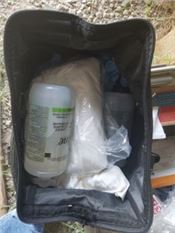Hope For The Best, But …. Have An Applicator’s Pesticide First Aid Kit Handy
DR. RIC BESSIN
PRINCETON, KENTUCKY
For many, applying pesticides can be a routine task. You go through the steps of donning PPE, checking equipment, measuring out pesticides and water, making the actual application, cleaning equipment and yourself, as well as notifying workers and recordkeeping. But sometimes, unexpected events happen: a broken hose under pressure, a leaky tank, a hose popping off the backpack sprayer, or just blowback from the nozzles. When you are contaminated with pesticides, you need to quickly get cleaned up.
Emergency First Aid
If someone has swallowed or inhaled a pesticide or gotten it in their eyes or on their skin, and the person is unconscious, having trouble breathing, or having convulsions, then call 911. Always check the pesticide label for directions on first aid for that product; these are generally on the first or second page of the label. For help with first aid information, call the Poison Control Center (800) 222-1222 or National Pesticide Information Center (800) 858-7378.
If pesticides are inhaled, remove the individual to fresh air immediately. Loosen the victim’s tight clothing. If not breathing, provide artificial respiration, preferably mouth-to-mouth. Open doors and windows so no one else will be poisoned by fumes. Seek medical attention.
It is a good idea to have a pesticide first aid kit handy and to bring it with you when making applications. Keep in mind that first aid is not intended as a replacement for care administered by professional medical personnel; rather, first aid is the initial effort to help a victim until professional medical help can be provided. A pesticide’s risk is a function of the toxicity of the material and a person’s exposure to the material. Exposure can occur through the eyes, skin, nose, mouth, stomach, or lungs. But another aspect is the time of exposure; the quicker the exposure can be interrupted, the better the exposure can be limited. Always check the label for pesticide- specific first aid procedures.
Pesticide First Aid Kit
Figure 1. The supplies in a pesticide first aid kit can help to limit amount of exposure when accidents occur. (Photo: Ric Bessin, UK) The elements of a pesticide first aid kit are: PPE to protect the victim and first aid provider, change of clothes, supplies to wash contaminated areas, disposable towels and supplies in case of pesticide ingestion. The first aid kit should be readily available when handling pesticides and well-marked.
Components of a pesticide first aid kit:
Gloves – good all-purpose gloves, such as barrier laminate, to protect against a wide range of pesticides. Remember to protect yourself from pesticide exposure prior to and while giving assistance.
Make sure you wear the appropriate personal protective equipment (PPE), including a respirator, before assisting someone in an enclosed area.
Coveralls – when a change of clothes are needed after contaminated clothes have been removed.
Liquid soap and clean water – a couple of gallons of clean water to decontaminate the victim. Avoid harsh scrubbing since this can increase pesticide absorption.
Saline eye-wash – hold the eyelid open and immediately begin gently washing the eye with clean running water or eye-wash solution.
Continue washing for 15 minutes. Cover the eye with a clean piece of cloth and seek medical attention immediately. If contact lenses are worn, remove and discard the contacts before washing the eyes.
Disposable towels
Syrup of ipecac – used only with ingestion of certain pesticides.
Read the first aid statement on the pesticide label carefully. Induce vomiting ONLY if emergency personnel on the phone or the product label tells you to do so. Never try to administer anything by mouth to an unconscious person.
Activated charcoal – used only with ingestion of certain pesticides when vomiting is not permitted. Read the first aid statement on the pesticide label carefully.
Emergency Help
After giving first aid, call the emergency number listed on the label and/or the Poison Control Center at (800) 222-1222. Have the pesticide label on hand when you call. ∆
DR. RIC BESSIN: Entomology Extension Specialist, University of Kentucky

Figure 1. The supplies in a pesticide first aid kit can help to limit amount of exposure when accidents occur.
Photo: Ric Bessin, UK